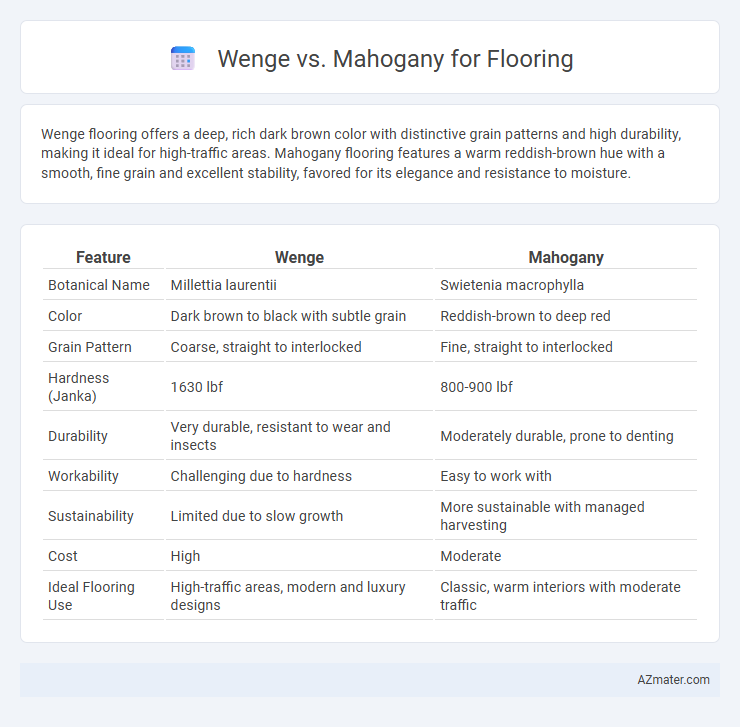Wenge flooring offers a deep, rich dark brown color with distinctive grain patterns and high durability, making it ideal for high-traffic areas. Mahogany flooring features a warm reddish-brown hue with a smooth, fine grain and excellent stability, favored for its elegance and resistance to moisture.
Table of Comparison
| Feature | Wenge | Mahogany |
|---|---|---|
| Botanical Name | Millettia laurentii | Swietenia macrophylla |
| Color | Dark brown to black with subtle grain | Reddish-brown to deep red |
| Grain Pattern | Coarse, straight to interlocked | Fine, straight to interlocked |
| Hardness (Janka) | 1630 lbf | 800-900 lbf |
| Durability | Very durable, resistant to wear and insects | Moderately durable, prone to denting |
| Workability | Challenging due to hardness | Easy to work with |
| Sustainability | Limited due to slow growth | More sustainable with managed harvesting |
| Cost | High | Moderate |
| Ideal Flooring Use | High-traffic areas, modern and luxury designs | Classic, warm interiors with moderate traffic |
Introduction: Wenge vs Mahogany Flooring
Wenge flooring offers a rich, dark brown hue with deep grains, providing a luxurious and contemporary aesthetic often favored in modern interiors. Mahogany flooring features a warm reddish-brown tone with fine, straight grains, known for its classic elegance and durability in traditional and upscale designs. Both hardwoods excel in hardness and longevity, but Wenge tends to be denser and more resistant to dents, while Mahogany provides a slightly softer texture with a timeless appearance.
Origin and Botanical Background
Wenge flooring derives from the Millettia laurentii tree native to Central Africa, prized for its dark, rich hues and dense grain structure. Mahogany originates from the Swietenia genus, primarily found in tropical regions of the Americas, known for its reddish-brown color and smooth texture. Both woods exhibit natural durability and resistance, making them popular choices for high-quality flooring materials.
Appearance and Color Differences
Wenge flooring features a deep, dark brown to black color with fine, contrasting streaks, creating a bold and dramatic aesthetic ideal for modern interiors. In contrast, mahogany flooring offers rich reddish-brown tones that add warmth and classic elegance, with a more uniform grain pattern enhancing traditional and rustic designs. The stark difference in color saturation and grain complexity between wenge and mahogany significantly impacts the room's ambiance and style.
Hardness and Durability Comparison
Wenge flooring exhibits a Janka hardness rating of approximately 1630, making it significantly harder and more resistant to dents compared to mahogany, which typically rates around 800 to 900. This increased hardness translates into superior durability for high-traffic areas and better resistance to wear and tear over time. Mahogany offers moderate durability with a softer texture, requiring more maintenance to prevent scratches and dents, whereas Wenge's dense grain structure ensures long-lasting performance in flooring applications.
Workability and Installation
Wenge flooring, known for its dense and hard texture, poses challenges in workability due to its tendency to splinter and require specialized tools for cutting and fastening. Mahogany offers superior workability with a softer grain, making it easier to shape and install, especially in complex layouts or intricate designs. Installation of Wenge demands experienced craftsmanship to avoid damage, while Mahogany's user-friendly nature allows for quicker and more efficient fitting, reducing labor time and costs.
Maintenance and Longevity
Wenge flooring offers exceptional durability and resistance to scratches, requiring minimal maintenance with regular sweeping and occasional polishing to maintain its dark, rich finish. Mahogany floors, while slightly softer than Wenge, provide excellent longevity when properly sealed and cleaned using mild wood cleaners to prevent moisture damage. Both hardwoods benefit from controlled indoor humidity levels to preserve their structural integrity and extend lifespan.
Cost and Availability
Wenge flooring typically costs more than mahogany due to its exotic status and limited supply, with prices ranging from $8 to $14 per square foot. Mahogany is more widely available and generally more affordable, averaging between $5 and $10 per square foot, making it a cost-effective choice for high-quality hardwood floors. Availability significantly influences price, as mahogany's broader distribution and sustainable harvesting practices contribute to its accessibility and lower cost.
Environmental Impact and Sustainability
Wenge flooring, sourced primarily from Central African rainforests, faces significant sustainability challenges due to slow growth rates and overharvesting, leading to concerns about deforestation and habitat loss. Mahogany, especially when sourced from certified plantations or sustainably managed forests, offers a more renewable option with faster growth cycles and better regeneration potential. Both hardwoods require careful consideration of certification like FSC to ensure environmental impact is minimized and sustainable forestry practices are upheld.
Best Applications and Design Styles
Wenge flooring excels in modern and contemporary design styles due to its rich dark brown color with black streaks, creating a bold, dramatic look ideal for minimalist and industrial interiors. Mahogany, with its warm reddish-brown tones and fine grain, suits traditional, colonial, and transitional styles, providing a timeless elegance and a cozy atmosphere in living rooms and formal dining areas. Best applications for Wenge include high-traffic areas and commercial spaces benefiting from its durability and stain resistance, while Mahogany is preferred for residential settings where aesthetic warmth and classic appeal are prioritized.
Wenge vs Mahogany: Which is Right for Your Home?
Wenge and mahogany are popular hardwood choices for flooring, each offering distinct aesthetic and durability benefits. Wenge features a deep, rich chocolate-brown color with fine, linear grain patterns, known for its exceptional hardness and resistance to wear, making it ideal for high-traffic areas. Mahogany boasts a warm reddish-brown hue with a smoother, more uniform grain, prized for its classic elegance and moderate hardness suitable for residential settings seeking timeless appeal.

Infographic: Wenge vs Mahogany for Flooring
 azmater.com
azmater.com